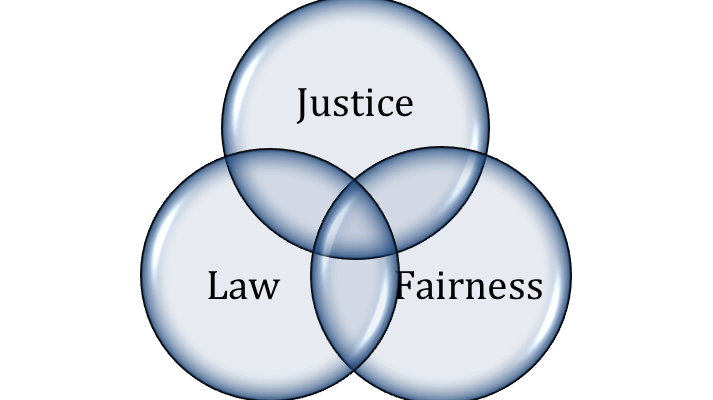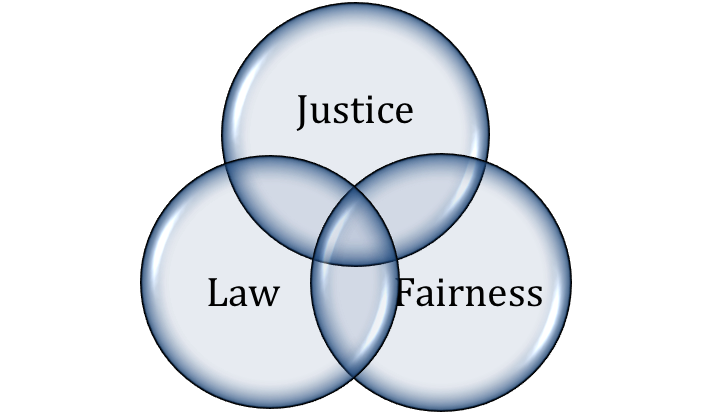Regular readers of this blog will know that I am exercised by the question of justice in mediation. I test the concept on people I meet; responses range from “that’s an interesting idea” to “it has nothing whatever to do with it”. At a conference earlier this year a senior lawyer claimed he could count on the fingers of one hand how many clients had ever mentioned justice. Others thought people choose mediation precisely because they don’t want justice, but some other thing – compromise, perhaps, or a deal.
I’m not so sure. I have a hunch that matters of justice pervade our clients’ thinking. That leads to the question: what is justice? And the answer, of course, depends on who you ask. John Rawls famously repackaged social contract theory to get around this problem via the “original position”: the idea that if we were to design society from behind a “veil of ignorance” about our abilities and social standing we would be very careful to make it as fair as possible (see John Rawls, A Theory of Justice. Oxford: Clarendon Press, 1972). Rawls described his theory in the words “justice as fairness” (p.12).
Now, had I asked lawyers if their clients cared about fairness I may have got a different answer. Most of us want things to be fair, an urge that starts in early childhood. There’s an interesting relationship between fairness and justice. In a fascinating study Wilson and Wilson ask why fairness seems to have a lower status than justice (see B Wilson and A Wilson, “Why Is Fairness Grubby? Semantics, Etymology, and Perspectives in Dispute Resolution” 13 Texas Wesleyan Law Review, 2006-7, p.795) They trace the etymological origins of the two words. “Fair” has Norse and Germanic roots and “justice” derives from the romance languages. Fairness is associated with everyday visual qualities such as balance and clarity; justice is the territory of the courts and the king, an establishment term whose roots in English can be traced to the Norman Conquest. So it is not surprising that those educated within the legal system are more willing to cede “fairness” to a collaborative process than “justice”. Ordinary or “lay” people can reasonably be expected to know about fairness, but justice is the domain of legal professionals. This debate is not new to the Anglo-American legal tradition, as illustrated by the ancient dichotomy between law and equity.
So far, so simple. Fairness is a universal urge but a subjective standard; justice is the domain of specialists but sets universal standards. What about law? This is always been a vexed question for mediators. When coining mediator styles as “facilitative” or “evaluative” Leonard Riskin also tagged them as “broad” or “narrow”. In the “narrow” style: “The most important issue tends to be the likely outcome of litigation” (L Riskin, 1996, “Understanding Mediators’ Orientations, Strategies, and Techniques: A Grid for the Perplexed” 1 Harvard Negotiation Law Review, 7 @ p.19). So, from the perspective of US commercial mediators, law is the default standard from which practice can broaden out to embrace business, personal and ultimately community issues.
But how does law operate in mediation? Does it matter to our clients? Does it matter to us? Should it trump fairness and justice? Or should fairness be the trump card that prevents both law and justice from perpetrating inequitable results (as in the tradition of equity)? For one school of legal scholars, law is simply about rules. If a rule is properly made, following the correct process, it is not the business of those who must apply it whether it is fair or just (I am caricaturing the position of legal positivists such as HLA Hart, see The Concept of Law Oxford: Clarendon Press, 1961). On the face of it this would leave mediation out in the cold, a form of “private ordering”. However, legal positivism can cut both ways. Suppose the State chose, via legislation, to deem mediation outcomes legally enforceable. Then these too would become legitimate sources of norms (Hart has a theory of “secondary rules” including “rules of adjudication” which deals with the way societies make the rules stick). Via this sort of secondary rule we could render mediation a source of law.
There are problems with this approach. One is the question of precedent. If mediations don’t set precedents, it is hard for them to provide normative guidance: how will people know what the law is if it might change in the next case? On the other hand, if mediations do provide precedent, why should they not be appealed if they are at odds with the law? But on what grounds and with what evidence might appeal courts scrutinise mediations? The logic of the outcomes, their “ratio decidendi”, is in the minds of the parties, not the mediators, and parties are not professional jurists trained in legal reasoning. An appellate structure is likely to lead to the demise of mediation’s informality and party empowerment.
While this sounds like the realm of speculation, in my own jurisdiction, Scotland, parties to a mediation can already render its outcome legally enforceable without further litigation. This is done via an ancient device called “Registration for preservation and execution in the Books of Council and Session” – essentially the registers of the country’s highest court. So Scotland has a secondary rule which can make a mediation outcome enforceable. Law is thus woven into mediation, as my diagram attempts to show.
The centre of the diagram may be a kind of sweet spot, where law, justice and fairness come together to the satisfaction of all. In real life, however, we may have to settle for achieving one overlap: an outcome that’s fair and just but not necessarily what the courts would do; or an outcome that’s just and legal but not necessarily what the parties regard as fair; or indeed one that is fair and legal but doesn’t fulfil wider ideas of justice. Whether some outcomes only fulfil one of the three poles I leave for now. My real purpose in this blog is to demonstrate that, like it or not, mediation involves a complex set of judgements about things that have mattered to people for as long as we know. A big question for the longer term is this: might mediation come to influence the law as much as the law influences mediation?
________________________
To make sure you do not miss out on regular updates from the Kluwer Mediation Blog, please subscribe here.





I really enjoyed this discussion since I once considered it as a topic for doctoral study. Would it require original research to determine how many mediation agreements actually reflect the possible “legal” outcome, or if not the legal outcome the normative views of a society?
Thanks Francis. You have rumbled me! I am at the start of a PhD on this subject. I will be comparing mediated and litigated outcomes in small claims in two Scottish courts. But evaluating the “legal” outcome would be tricky, so my intention is simply to look at numbers – sum sued for v sum received – and then ask a sample of respondents how they view the fairness of the result.
Charlie – as always, an interesting and important topic. It’s ironic, isn’t it, that what began as a discussion of “access to justice” some 40 years ago, it at risk of forgetting that latter part of the equation, or assuming that justice is readily reduced – as we’ve discussed before – to the aggregation of private preferences or the satisfaction of interests. It tends, therefore, to be left to those standing outside of the citadel – writers like Fiss, Luban, Genn – to ask these tricky questions about the connection between law and justice . . . and fairness. I look forward to hearing more of your project as you get immersed in it.
Cheers,
Ian
Thanks Ian. You are on the money, as ever. One of my students this year is looking at access to justice – something the psychologists might describe as a ‘fuzzy’ or ‘slippery’ concept. The justice part is rarely unpacked. Perhaps that’s because it is a little daunting!
Dear Charlie,
A very interesting discussion, which
is much needed in view of the inconsistency and confusing manner in which the
concepts of justice and fairness are employed in mediation literature. You
might want to have a look at my attempt to deal with these concepts in Omer
Shapira, Conceptions and Perceptions of Fairness in Mediation 54 S. Tex. L. Rev. 281 (2012). Drawing on literature from philosophy, morality,
professional ethics, jurisprudence, and mediation I identify perspectives of
fairness which clarify the meaning of fairness in mediation and provide tools for
a better understanding of what codes of conduct and mediation literature on justice
and fairness mean when they make assertions of Justice, fairness and unfairness. Hope you will find it interesting and helpful in your project.
Omer